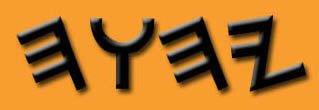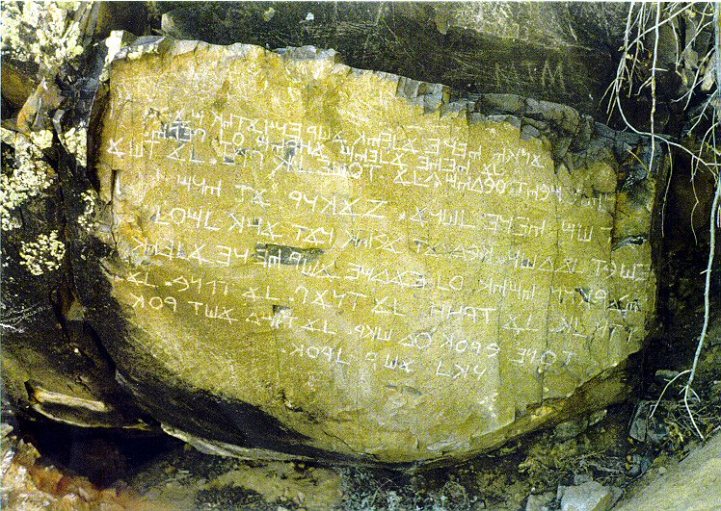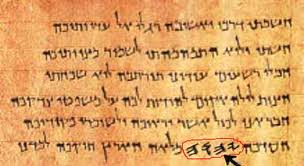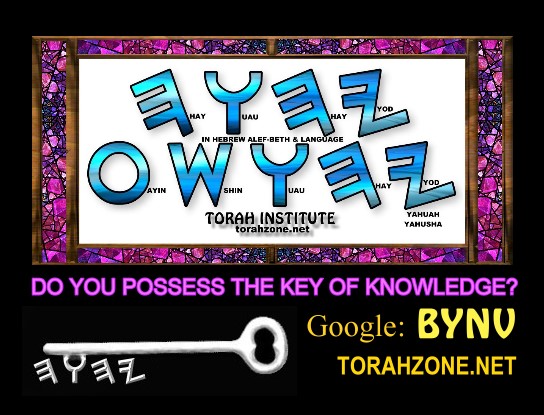
HIEROGLYPHIC HYKSOS HOAX

COMPARISON LETTER CHART AT BOTTOM OF PAGE
The letters we are seeing all over the Internet are a mixture of scripts, one
Hebrew letter (UAU) and the others Egyptian hieroglyphics.
Part of our confusion is that the square script called "modern Hebrew" is really
Aramaic, the script brought back from
the captivity in Babel. There's only one true Hebrew script.
We're turning aside to myths very rapidly.
The Name of Yahuah has never before been seen written as shown, until it
appeared in the electronic drawings. Real Hebrew script is pictographic, as is
the hieroglyphic script. When someone finds the Name written in the way we are
seeing it today, then perhaps we can accept that Hebrew evolved from
hieroglyphics. Reveal any physical evidence you can find mixing these scripts (bullae/seals,
pottery shards, reliefs, parchments or whatever) and what you are seeing will
have concrete verification. Until then, the basis is merely a chart invented by
men.
Videos teaching the Name of Yahuah
are popping up all over the Internet. Their
use of Scripture supporting the Truth of the Name is commendable.
There are some elements contained in the teachings
which are highly skewed, and cause some to stumble as they try to draw closer to
the original Hebrew.
The letter
W
(double-U)
causes stumbling, since it is almost as new as the letter
J;
it’s a doubling of the letter
U.
There is no double-U in Hebrew, so teachers passing it into future generations
propagate an error that should be easy to overcome.
The letter W is came into use due to the
development of the printing press.
www.fossilizedcustoms.com/w.html (link)
We’re only transliterating, so it should be expressed as simply and
literally as possible.
In illustrations, we see the
promotion of the proto-Sinaitic script of the Hyksos, Kananites, who left a
handful of hieroglyphs in the turquoise mines at a site called
Serabit ha’Khadem
in the Sinai.
There is no inscription, scroll, bullae, coin, stamp, seal, or bas
relief depicting the Name Yahuah in hieroglyphs as many are now using them.
Pharaoh declared “I do not know Yahuah” - so he had never heard or read
the Name.
Original Hebrew letters are
pictographic; but the promoting of the Hyksos-hieroglyphic pictograms imply that
Hebrews (such as Abraham and his descendants through Sarah, Hagar, and Keturah)
somehow learned how to write from Mitsrayim, or Kananites, or the mysterious
“Phoenicians” who were given their Greek name by Herodotus (5th century BCE).
Even the oldest form of Kananite writing, cuneiform, was an adaptation
from palaeo-Hebrew.
Cuneiform used
a stylus to form
entire
words
as symbols, rather than pictographic letters, and writing used less space.
The edict of Cyrus (really Koresh) was written in Akkadian cuneiform,
announcing the order to rebuild the Temple of Yahuah in Yerushalayim (see Ezra
1, YashaYahu 45, Danial 1), and this edict can be seen online by anyone today.
The Cyrus cylinder was discovered at Babel
in 1879:

The Hyksos that wrote the letters
on the walls of the turquoise mines in the Sinai Peninsula were illiterate, and
imitating what they saw nearby at the temple of Hathor, an Egyptian deity for
whom they mined the turquoise.
They
were not forming words, and drew randomly with no language rules guiding their
scribbling.
A gentleman (I will not name) came
out with a book a few years ago [The Ancient Hebrew Lexicon Of The Bible]
showing
charts
with alphabets arranged with letters mixing together the palaeo-Hebrew letters
with about 7 or 8 of these foreign hieroglyphic / pictographic letters, and now
we see these on the Internet displaying the Name of Yahuah in this script.
An
alphabet
is usually associated with a
language.
If we write the Name of Yahuah with our so-called English
(Anglish) letters, we
are really using Latin letters (another language) to express the Hebrew
language, apart from its alphabet. The Kananite Hyksos did not serve Yahuah, and
never wrote His Name in these hieroglyphs, which they borrowed from the language
and writing of Mitsrayim.
The
oldest Hebrew ever found on this planet was not associated in any way with
hieroglyphs, or cuneiform.
These
forms of writing developed from the palaeo-Hebrew, not the other way around.
What we are witnessing is revisionism, and as teachers we need to make
certain we do our research based on real evidence, not charts drawn in books.
We’ve all seen charts depicting the “geological column” in books, but
these charts are nothing like the real geological layers, and so we have
teachers in schools picking up the errors of former teachers, passing false
concepts into future generations.
If you Google “proto-Sinaitic
script of the Hyksos” you will discover it is a discussion concerning who
invented writing. What we call palaeo-Hebrew is the original, and it
is
pictographic.
Noak surely had the
writings of Kanok, a pre-Flood prophet, and yet archaeologists are suggesting
that while Abram was conversing with the Creator of the Universe around 2000
BCE, Chalcolithic Kananites were inventing writing on the walls of caves in the
Sinai Peninsula.
Not likely.
The fact that the palaeo-Hebrew
letters of the Name pictographically reflect a kind of
acronym
is not a problem at all (behold
the nail, behold the hands).
To make it work, one must read it backwards.
Yahusha’s body still bears these scars we caused.
I would recommend using the Hebrew
alphabet to illustrate the Hebrew language, rather than the Egyptian alphabet to
express the Hebrew language.
Our fellow Natsarim using the
Hyksos script are basing it on what was on a chart in a book, not from any
physical evidence left behind by any culture of the past that wrote and spoke
using these characters to write Yahuah’s Name.
Yahuah wrote His Name in the
familiar characters we know as palaeo-Hebrew, as we can see on the Great
“Isaiah” (YashaYahu) Scroll at the Hekal Sefer (Shrine of the Book) in
Yerushalayim.
It’s real evidence
from the past, and not a hoax. The other doesn’t exist in the real world, only
in charts, just like the fake charts of the “geological column”.
We need to show people real
evidence, which many do with photos of coins, seals, bas reliefs, and
scrolls.
But as teachers
depart from physical evidence and invent diagrams and charts, we fall into the
same kind of misdirection caused by the “geological column” charts used in
schools today.
Charts can be
helpful only if they are accurate. If the Name of Yahuah has never been found
written by anyone in the past as seen in the script at the above left, the
back-story we are hearing is a hoax.
Yahuah’s Name has been found written on the black obelisk of Shalmanezer
III discovered in Babel. Below, I’ve included the clay cylinder photo of the
edict of Koresh, called “Cyrus”, the Moabite Stone, and a stone found in
Shomeron. Physical evidence of Yahuah’s Name is real.
Stones are literally “crying out” the Name, even in remote locations such as the
one at Los Lunas, New Mexico USA, but not in a Hyksos script.
There is not a single scrap of the proto-Sinaitic Hyksos pictographic expression
of the Name of Yahuah anywhere. When such a thing is discovered, we can use it
and teach with it, but not until then.
This is the original, ancient
script:





Above: Los Lunas Stone in New Mexico, with 10
Commandments, a village gate requirement (Dt. 6:9)




Example of cuneiform script on the actual edict of Koresh
referenced at Ezra 1
Please look for more evidence than what is presented to you
in a chart like this one:

If you build a chart, some will believe the real world
matches it.
The Truth is like a lion; all you have to do is release it, and it can
defend itself.

Have you ordered the new BYNV?
“This is written for a generation to come, So that a people to be created praise
Yah.”
Tehillim - Psalms 102:18
Torah Institute
POB 436044, Louisville, KY 40253
To order online NOW:
The Hebrew was the main source used
for accurately conveying word meanings, expressions, and transliterating names
and other words. No small number of former translations were consulted, but a great cloud of them for their best parts, leaving
aside the unclear or out-right erroneous elements.
This Besorah Of Yahusha is not based on the former one in any way; the
only thing that I consulted from that version was my own preface material, which
was the extent of my involvement in that effort.
The Hebrew text, and to some extent the Greek RT for the Natsarim
Writings, were the sources that resolved difficult passages, and settled the
vocalization difficulties. For
example, the word Caesar is not in the Hebrew, but is in the Greek. In this new
Besorah Of Yahusha, it is transliterated "Kaisar" as it originally appears
in the text. The text
consulted for this included the Kohlenberger Interlinear Hebrew-English, Hendrickson's
Interlinear Hebrew-English.

Order BYNV at: http://www.torahzone.net/ TAKE
TIME TO VISIT THE BLOG, YOUR COMMENTS WELCOME
Amazon Kindle, BYNV:
You can review the text without purchasing it.
To review, or download the BYNV Kindle (and save shipping):
LINK TO 1 HOUR 50 MINUTE DISCUSSION ON WHAT THE NEW TRANSLATION IS LIKE:

TORAH INSTITUTE
PO BOX 436044
Louisville, KY 40253-6044
phone:
502-261-9833
google: BYNV





www.torahzone.net




















